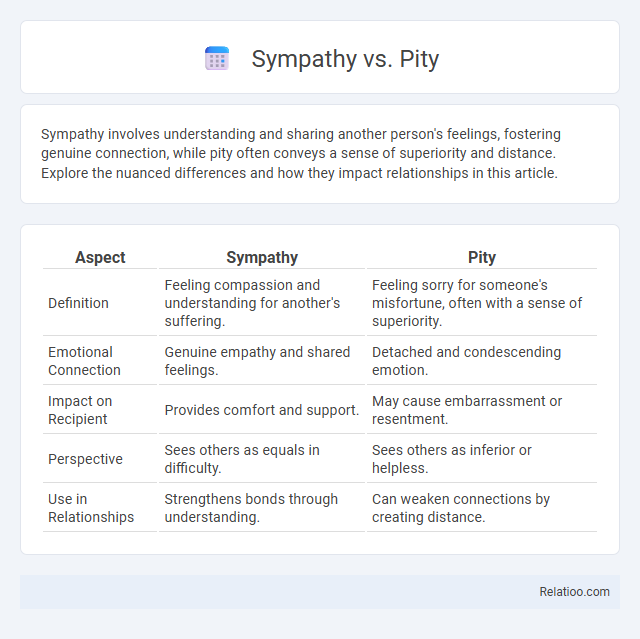Sympathy involves understanding and sharing another person's feelings, fostering genuine connection, while pity often conveys a sense of superiority and distance. Explore the nuanced differences and how they impact relationships in this article.
Table of Comparison
| Aspect | Sympathy | Pity |
|---|---|---|
| Definition | Feeling compassion and understanding for another's suffering. | Feeling sorry for someone's misfortune, often with a sense of superiority. |
| Emotional Connection | Genuine empathy and shared feelings. | Detached and condescending emotion. |
| Impact on Recipient | Provides comfort and support. | May cause embarrassment or resentment. |
| Perspective | Sees others as equals in difficulty. | Sees others as inferior or helpless. |
| Use in Relationships | Strengthens bonds through understanding. | Can weaken connections by creating distance. |
Understanding Sympathy and Pity: Core Definitions
Sympathy involves genuinely sharing and understanding another person's feelings, often providing comfort and emotional support. Pity, in contrast, is feeling sorrow or compassion for someone's misfortune, but can sometimes imply a sense of superiority or distance. Understanding these distinctions helps you navigate emotional responses with empathy, fostering deeper human connections.
Emotional Depth: How Sympathy and Pity Differ
Sympathy involves genuinely understanding and sharing the emotional experience of others, reflecting a deeper emotional connection compared to pity, which often implies a feeling of sorrow or compassion from a distance without true emotional engagement. Your ability to offer sympathy fosters empathy and emotional support, while pity can unintentionally create a sense of superiority or detachment. Grasping these differences enhances your interpersonal relationships and emotional intelligence by promoting authentic connections.
The Psychological Roots of Sympathy vs. Pity
Sympathy originates from an empathetic emotional resonance, engaging mirror neurons that enable individuals to genuinely share and understand others' feelings. Pity, by contrast, stems from a cognitive evaluation of another's misfortune, often accompanied by a sense of superiority or detachment rather than shared emotion. The psychological roots of sympathy involve active emotional connectivity, while pity is rooted in judgmental cognition and social hierarchy perceptions.
Impact on Relationships: Building Connections or Creating Distance
Sympathy fosters genuine emotional connection by showing understanding and compassion, strengthening Your relationships through empathy. Pity, however, can create distance as it may imply superiority or judgment, making others feel belittled or misunderstood. Empathy goes deeper, promoting trust and openness by truly sharing and validating the feelings of others, crucial for meaningful relationship building.
Sympathy as Empathy’s Ally: A Bridge to Compassion
Sympathy serves as a crucial ally to empathy by creating a bridge to compassion, allowing individuals to acknowledge and share the feelings of others without judgment. While pity often implies a sense of superiority and sympathy can risk emotional distance, true sympathy harnesses empathetic understanding to foster genuine connection and support. This nuanced emotional response promotes compassionate actions by validating experiences and encouraging deeper interpersonal bonds.
Pity: Origins and Social Implications
Pity originates from the Latin word "pietas," meaning dutifulness or devotion, and evolved to describe feelings of sorrow for another's misfortune. It often implies a hierarchical relationship where the pitier perceives the pitiable as inferior or vulnerable, which can reinforce social stigma and power imbalances. In social contexts, expressing pity may inadvertently distance the giver from the receiver, highlighting inequality rather than fostering genuine empathy or solidarity.
Language Matters: How We Express Sympathy and Pity
Sympathy and pity are often confused, but language nuances shape their emotional impact and social perception. Sympathy conveys genuine understanding and shared feelings, fostering connection, while pity implies a hierarchical view that can feel condescending and less empathetic. Choosing the right expression matters for your communication, as it influences how support and compassion are received and perceived in personal and professional interactions.
Sympathy vs. Pity in Popular Culture and Media
Sympathy and pity are often portrayed distinctly in popular culture and media, where sympathy is associated with genuine empathy and understanding of another's feelings, while pity is frequently depicted as condescending or detached sorrow. Films, television shows, and literature use sympathy to build deeper emotional connections between characters, encouraging viewers to relate and respond compassionately. Your perception of emotional support can evolve by recognizing these nuanced portrayals, which shape how society values empathy over superficial or patronizing attitudes.
Why Choosing Sympathy Cultivates Respect and Dignity
Choosing sympathy over pity fosters respect and dignity by valuing a person's emotions without judgment or condescension. Sympathy involves understanding and sharing feelings, which creates a connection based on empathy and human equality. In contrast, pity often implies superiority and fosters dependence, undermining the individual's self-worth and empowerment.
Transforming Pity into Positive Support
Transforming pity into positive support involves shifting from feelings of condescension to genuine empathy, fostering connection rather than distance. Sympathy means sharing emotions and understanding another's pain, while pity often implies judgment and separation, which can hinder effective help. Emphasizing sympathetic responses encourages active listening and compassionate actions that empower individuals instead of reinforcing their struggles.

Infographic: Sympathy vs Pity
 relatioo.com
relatioo.com